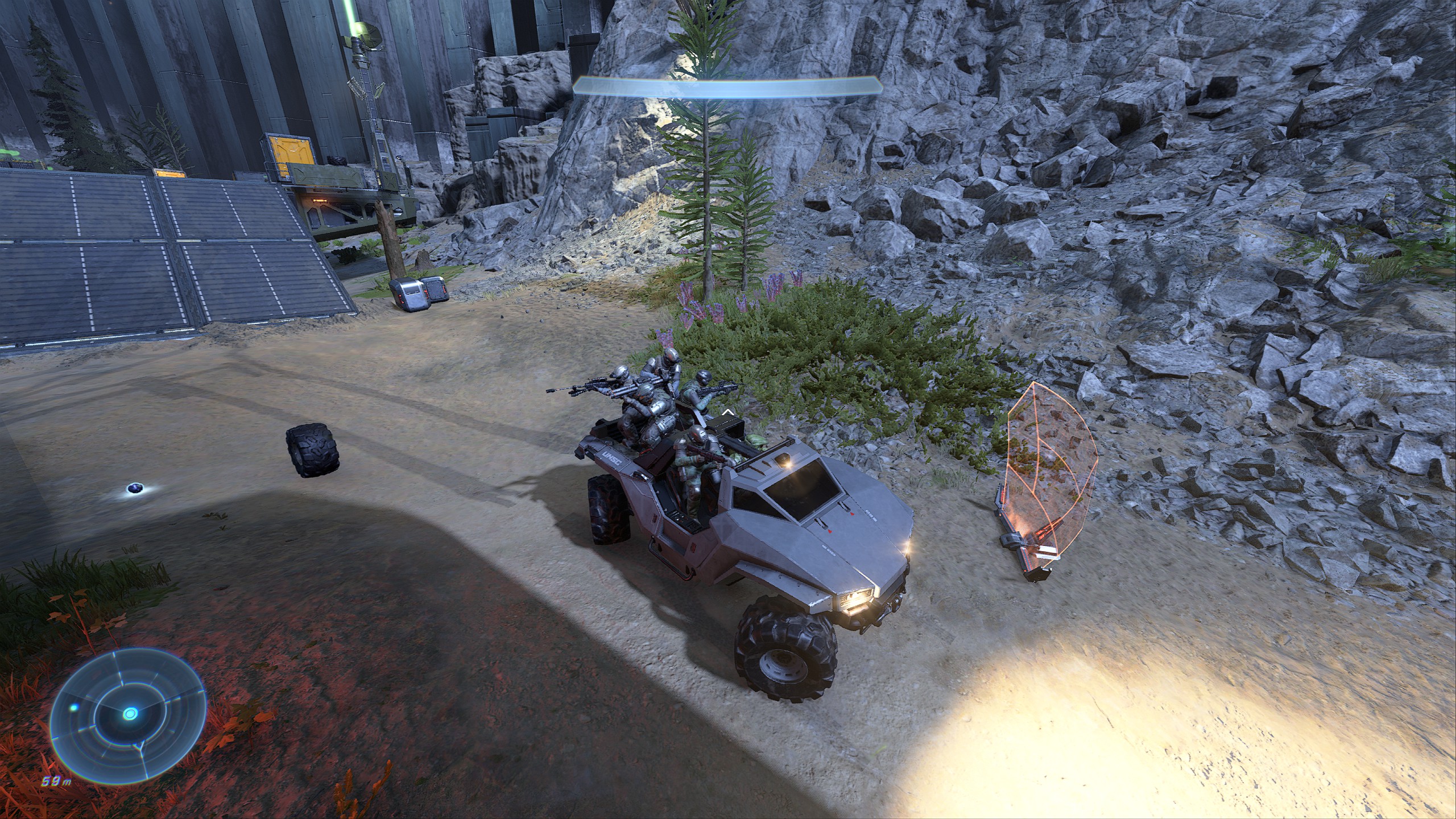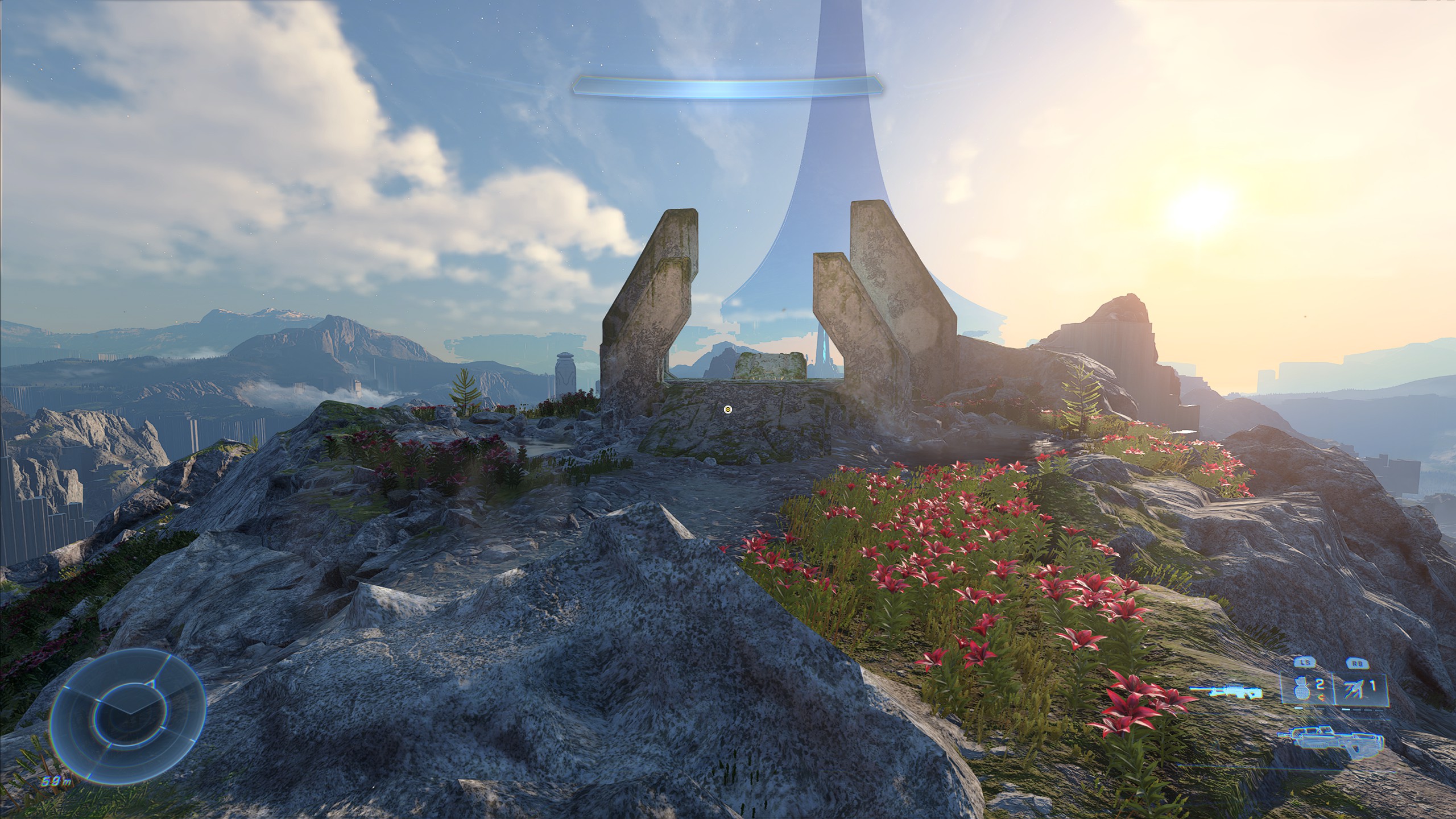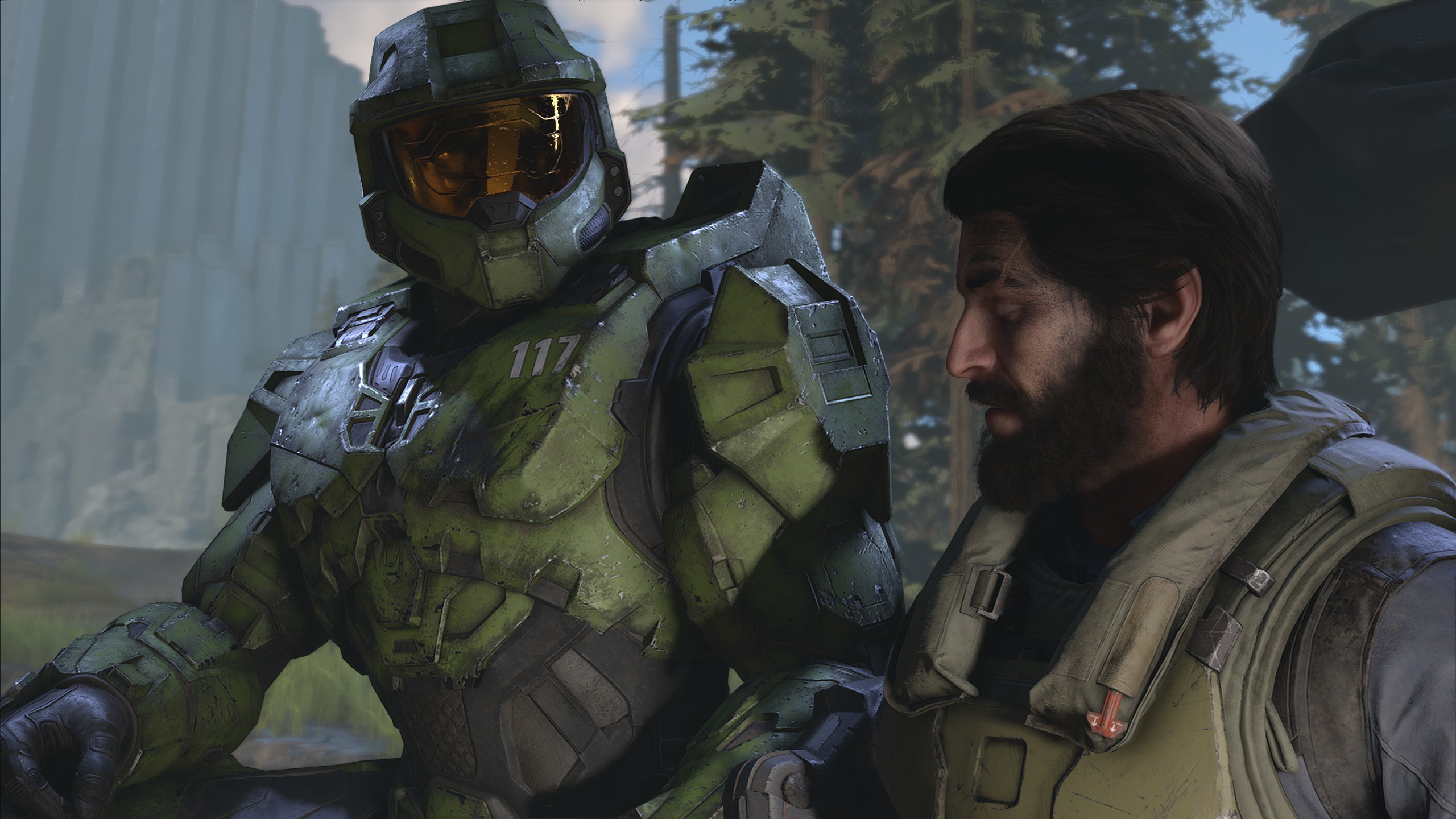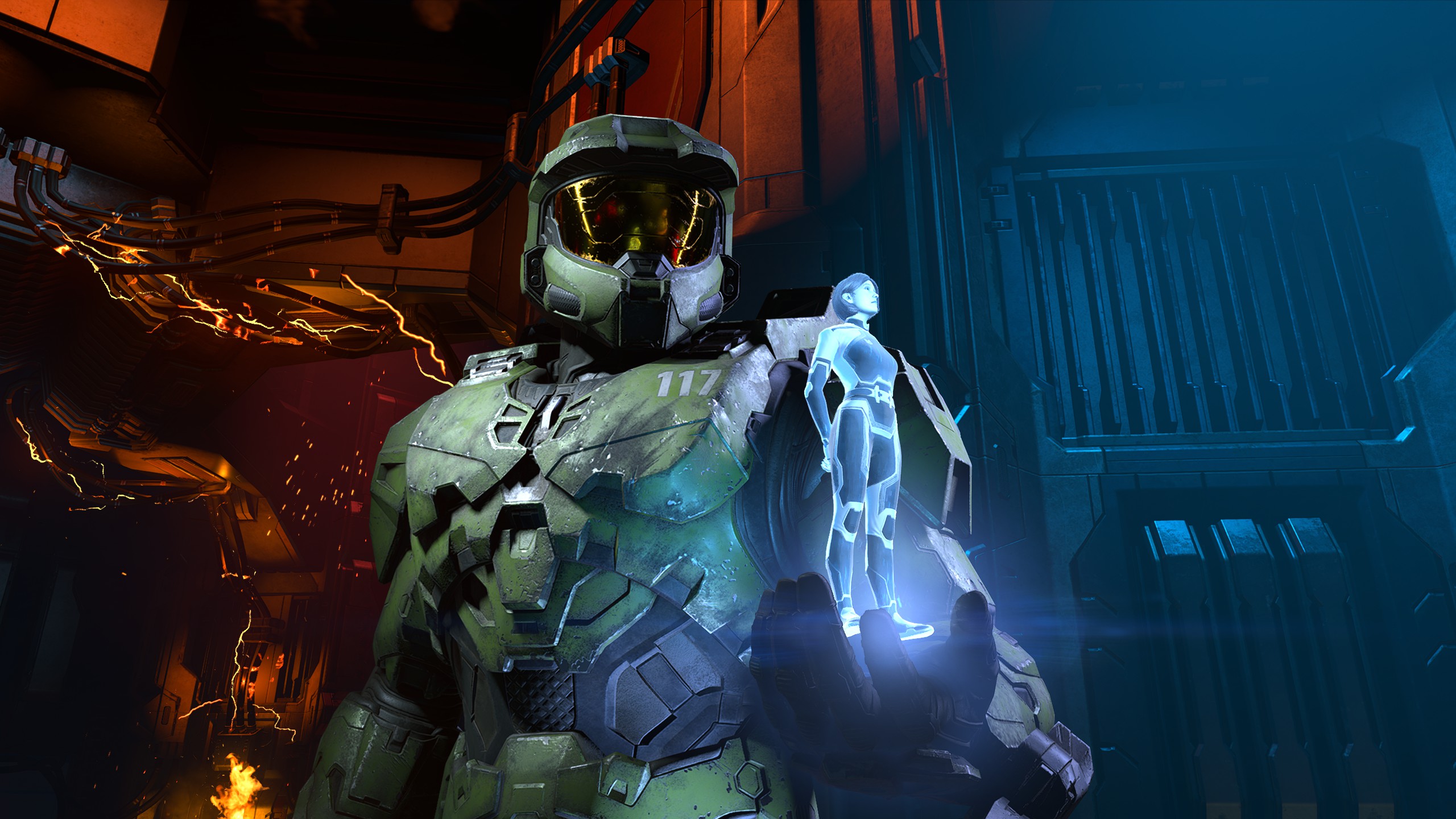Our Verdict
Halo Infinite can't quite deliver on being an open-world throwback, but it's the best shooting the series has seen to date.
PC Gamer's got your back
What is it? Halo, but with an open world.
Reviewed on RTX 2070 SUPER, Ryzen 5 3600, 16GB RAM
Price $60/£50
Release date December 8
Publisher Xbox Game Studios
Developer 343 Industries
Multiplayer? Infinite's free-to-play multiplayer came out last month.
Link Official Site
Does an open world work for Halo? Since its announcement, that question is one that's been constantly asked of Halo Infinite. Six years after the sour note of Halo 5, 343 Industries has dusted off the Master Chief's armour for a throwback to Bungie's original, pointedly nostalgic for a time when Halo was just a big green man, his blue holographic girlfriend and a wide open ring full of possibilities to explore.
What this results in is a game that could be a true return to form for Master Chief—but I'm just not convinced Halo really needed to be an open world.
Let's make one thing clear though: this is some damn fine Halo. Having played Halo 3 with the lads every weekend for the last year, Infinite comes as a breath of fresh air. Running and gunning in Halo has never felt this good, Master Chief moving with a real heft even as he slides and mantles his way across ancient alien amphitheatres.
Halo Infinite's multiplayer gave us a taste of this, launching a month ahead of the story proper. But where the game's arsenal feels a little flat in team slayer, the campaign helps even the flimsiest weapons shine thanks to a menagerie of alien baddies with unique behaviours. Weapon types have never felt more important, especially on harder difficulties (I played through on Heroic), and juggling between bursting shields with plasma, busting skulls with kinetic and stunning foes with shock weapons becomes crucial. I hate the Pulse Carbine in multiplayer, but in the campaign it became a brutally efficient Elite-slaying machine.
It helps that every weapon feels great, snapping and popping and busting with satisfying sounds. Infinite's firefights feel electric, hectic, a constant grab-bag of finding the next best tool (even if that means tossing a nearby plasma barrel at a pack of Grunts).
None of this comes close to the sheer absolute thrill of the grappling hook. Infinite immediately hands you a Titanfall 2-style length of rope with which to fling yourself around Zeta Halo with. At first you're pulling yourself out of enemy fire and grappling vehicles, but a few upgrades will turn it into a deadly electric wire that shocks unshielded baddies and lets you slam-dunk entire packs of foes with a tap of the melee button.
This does come at the cost of making the rest of the equipment feel a little redundant, mind. Changing equipment on the fly is a hassle and—besides using the threat sensor to reveal cloaked Elites—you're always best served with the utility (and shockingly-fast cooldown) of a hooked rope.
Ring road
I'm only looking at Infinite's campaign in this review, but that's only because we've already been playing multiplayer with the rest of you for the past month. It's incredible stuff, but one that's hindered by limited modes, somewhat flat weapon balancing, and a progression system that straight-up sucks. The game's first limited-time mode only exacerbated problems with an uninspiring cosmetics pool and frustrating challenges, and while 343 says it's listening, these are errors free-to-play games learned not to make years ago.
Playing with my regular Halo buds online is still a blast, but I'm quickly burning out of Infinite's arenas.
That grapple is also essential for exploring Halo Infinite's open world. Introduced after two more traditionally linear missions, Infinite introduces you to the open-ish plains of Zeta Halo. But while your AI sidekick (more on her later) immediately floods your map screen with icons, don't be fooled. This isn't Far Cry: Ringworld—in fact, you'll find the open world to be surprisingly small.
Instead, these activities feel more like diversions between main story missions. While heading to your next plot beat you might find a squad of marines to rescue or an FOB (bases from which to fast travel and summon weapons and vehicles) to capture. They're fun, but incidental—and while the larger strongholds provide a more structured, traditionally 'Halo' challenge (shut down a refinery, demolish a weapons cache, punch through a blockade), I rarely felt the pull to break off from the main path to devote time to them.
See, Halo doesn't lend itself well to a drip-feed of unlocks. Main story missions are tightly controlled and rarely let you just rock up with a tank. Powerful weapon variations can be acquired by taking down high-value targets in the open world, but levels are constantly throwing completely different challenges in your face. Why cling onto a long-range Sidekick variant when a mission just tossed you into a pit of beefed-up Elites?

There's perhaps one mission that makes use of the open world structure, a mid-game level that tasks you with crossing kilometres of space to infiltrate Forerunner beacons fiercely held by Banished forces. It's here where all those toys you may have unlocked can finally come into play—one final effort at an open world Halo, before Infinite sort of gives up on pretending to be an open world entirely in its final hours.
Halo Finite
But Halo Infinite is still an open world, and even when it guns back into a more traditional pace in the latter half, it can't escape that structure. The Forerunners must have loved their trip to Seattle, because Infinite's world is all minor variations on the same Pacific Northwest environment. Because the story needs to take place within this small chunk of Zeta Halo (less an expansive ringworld and more a modest national park), missions can't break off into desert vistas, frozen valleys or dense urban warzones. Enter a mission, and you're guaranteed it'll be some combination of pine forests and pristine Forerunner structures.
Don't get me wrong, it's a beautiful forest. Infinite is a gorgeous game, omitting the overdesigned characters and environments of 343's previous games to create a well-considered evolution of Bungie's visuals. Forests are thriving with wildlife, grass sways in the breeze, and Forerunner structures feel suitably imposing. That ring on the horizon is physical, interacting with the sun and casting long shadows across itself.

But that familiarity robs missions of a unique identity, and after finishing the game the only mission that stands in my memory is a late-game level in a particularly fun Banished facility. The open world's lush forests, valleys and marine-rescue setup may strongly evoke Halo (the mission) from Halo (the 2001 series debut), but none of the main missions stand up against the timeless design of The Silent Cartographer, or even Halo 3's less-fondly remembered meat labyrinth, Cortana.
In the moment, level and encounter design is great. 343 is so careful to make sure fights never feel overly familiar, always throwing new pain points into the mix. There are even moments that call back to highs from earlier games—fending off Sentinels from a painfully slow gondola, tearing down valleys in a Scorpion tank. But there's nothing as spectacular as the time Halo 3 dropped two building-sized Scarabs on top of you and told you to figure it out.
Instead, Infinite has boss fights. These mostly see you kiting the boss around a small arena figuring out the best way to crack their shields before finishing them off, a more bullet-spongey variation on Halo's core loop with more punishing attack patterns. They're fine, if a bit overlong. But there's a special place in hell for a pair of Brutes you're forced to face in an open ditch—one riding a souped-up Chopper while the other nukes you with artillery fire, summoning extra baddies when either is defeated.
Think Ornstein and Smaugh with grenade launchers, and you'll understand my pain.
The Not-So-Silent Cartographer
But the biggest frustration is that, for as much as Infinite has been earmarked as a throwback to the series' roots, 343 can't shed the baggage the series' lore has accrued over the last 20 years. It's frustrating because at the root of the game is the relationship between Chief, the UNSC Pilot who rescues him at the game's opening, and The Weapon—an AI modelled after Cortana after Cortana went all galactic dictator-god at the end of Halo 5.

Halo Infinite has been running fairly flawlessly on my 2070, and while I've had one or two sudden crashes on multiplayer, the same can't be said of the campaign which remained rock-solid throughout. If you're looking to squeeze a little extra juice out of the game, however, Infinite has a fairly robust set of graphics options, outlining how much VRAM each setting will demand of your hardware.
Special mention has to be made of Infinite's suite of accessibility tools. On top of fully rebindable controls, there are dozens of settings for controlling everything from sensory effects like speed lines and screen shake, multiplayer team colours, the size and appearance of subtitles, and text-to-speech options both for multiplayer text chat and menu options.
At its heart, this dynamic works! Chief is starting to feel tired after all these years of being a videogame hero, but his constant need for heroics and duty creates a wonderful tension with a stranded Pilot who is at the absolute end of his tether. The Weapon often risks coming across as gratingly naive and occasionally whedonesque in her quips, but she feels like a knowing throwback to Halo 1's version of Cortana—a friendly voice to accompany you through ancient ruins and apocalyptic schemes. A family can be a big green man, his blue holographic partner and a nervous wreck at the helm of a 130-ton dropship, and that's okay.
They're a good foundation for a story, but unless you're clued in on Halo 5 (and RTS spin-off Halo Wars 2) the story is a hot confusing mess. The Banished simply aren't interesting baddies, a straight reskin of The Covenant only redder and meaner, but they soon share the stage with 343's favourite trope. Halo's established ancient aliens, The Forerunners, aren't mysterious anymore, so we're introduced to a new ancient alien who has a grudge against the Forerunners and, by proxy, humanity.
Any mystery Halo used to hold has been lost under a deluge of proper nouns and thousand-year machinations, and keeping track of it is exhausting. That's likely why, when all is said and done, the story isn't even really about The Banished, or The Harbinger, or The Endless. It's about Master Chief and Cortana, a relationship that even with the latter's absence, drives everything our big green man does throughout the game. And truth be told, it's not a relationship that's ever worked for me.
Fight finished
Infinite wants to kick off a new era of Halo by asking why we fell in love with it in the first place. In moments, even my jaded old heart can feel it. Exploring the open world after wrapping the campaign is a joy, exploring nooks and crannies for secrets, basking in the alien beauty of watching the sun set behind the ring and rising on the other side of it moments later. Wrapping up all those side missions I skipped and admitting that they probably were best left until now, when I'm done with the story but still hankering for some good Halo fights.

Halo Infinite really is good Halo. For lapsed fans of the Bungie games like me, Halo Infinite is a strong return to form, and in the heat of battle it's the best running and gunning the series has ever had. It's painfully easy to imagine a world where Infinite could have easily been one of my favourite entries to date. But between an open world that feels largely redundant and a story that can't shed the series' baggage, Halo Infinite's campaign falls just shy of being great Halo.
Halo Infinite can't quite deliver on being an open-world throwback, but it's the best shooting the series has seen to date.

20 years ago, Nat played Jet Set Radio Future for the first time, and she's not stopped thinking about games since. Joining PC Gamer in 2020, she comes from three years of freelance reporting at Rock Paper Shotgun, Waypoint, VG247 and more. Embedded in the European indie scene and a part-time game developer herself, Nat is always looking for a new curiosity to scream about—whether it's the next best indie darling, or simply someone modding a Scotmid into Black Mesa. She also unofficially appears in Apex Legends under the pseudonym Horizon.


